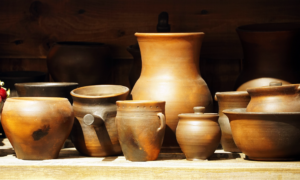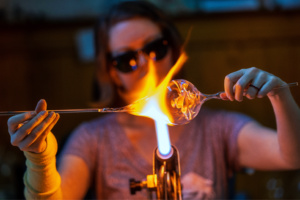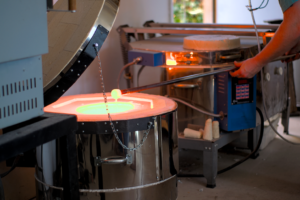Even if you have spent years developing your skills as an artist in the creative fields of pottery, ceramics, or glass work, and have experimented with a very wide range of techniques, materials, tools and approaches, these disciplines offer seemingly endless creative processes with infinite results, which follow no other rule than imagination. In this article we will see what are the best glass fusing kilns for home use.
The Very Beginning
Glass working itself is one universe in this creative cosmos. But how did it all start? Ancient Egyptians were masters of imaginative and advanced glassworking techniques. But it all may have started as an accident.
It is said that civilizations in Mesopotamia or Egypt started working with new techniques to preserve and make everyday objects harder, such as plates, bowls, and other types of containers for food and liquids. And glass appeared as a by-product of processes like metal working and others similar to today’s glazing.
Glass can form naturally from volcanic magma or when lighting hits sand rich in silica. Crystals like obsidian and quartz are formed. So, at first, humans molded natural glass without knowing the process of creating it. Then, when technology for glass making was developed, glass working as an art appeared, and artisans started to master its craft.
If we could talk to one of these fine and wise artisans, we would probably find that they first mastered fire, water, and earthing materials, especially silicas and quartz, if we were focusing on the art of glass.
Modern Glass Working
On the subject of modern glass working, we must point out that firing has become an art itself. We are not saying it was not an art in the early years. We also know that it has always been a really complex art, but it needed and had different tools and approaches. It simply was another creative universe where artisans created their pieces with the boundaries of the technical knowledge of their time.
Now apply this to modern glass working art and think: what will the future look like?
Furthermore, as it is today, and it has also been in the past, the work and knowledge of materials themselves is a universe full of creative pathways.
As we said, ceramic, clay, glass, and other material firing has always been an art, the thing is that now you, as an artist and creative person, have a wider range of methods, tools and, a variety of ways and instruments to measure certain important firing parameters like temperature, firing and annealing time. This adds more complexity to the full spectrum of experimentation.
Best type of Kiln for Home use: Small Glass fusing Kiln
By knowing that to make a fused glass design you should consider joining two or more portions of compatible glass, and that you need certain temperatures depending on your goals, you can choose the right glass fusing kilns for home use. Usually, small glass fusing kilns are good options to start with.
The how and how long you apply heat to your creations affects certain characteristics from durability, full or tack fusing, texture, to color and transparency, and since the kiln you use may or may not offer some degree of modulation of firing time and temperature, each tool and its scope must be carefully considered.
Also, you can find a wide variety of glass fusing kiln sizes and power capacities, which influences the way heat is directed to your glass masterpieces, so firing time must be adjusted depending on the pieces, materials, and goals.
Mastering this instrument can help you achieve your desired goals and can lead you to other creative processes and artistic universes. We would like you to know that when looking for upgrading or changing your tools or working materials or both, expanding your creative horizons, and finding that special original and personal touch, kilns could represent the most desired tool to master and improve.
So, on the subject of glass fusing techniques, the horizons are wide, and the landscape color, shape, vegetation and complexity depends on where you are standing and where you are looking to. Let’s start with the basics: which are the most common glass fusing techniques that you can apply to your practice?
Glass Fusing Techniques
The feeling that there are endless ways to approach glass working art can be overwhelming. If that’s your case, you could lean on some well-known techniques. You may already know them, or you may be surprised.
- Fused Glass
Fused glass is one of the easiest and most fun techniques for glass working. As its name suggests, fused glass refers to the practice of heating two or more pieces of glass in a glass fusing kiln so that they melt together. Usually, the needed temperature for melting and fusing glass is between 1350 to 1500 °F (730 to 820 °C).
You can make jewelry, plates, bowls, vases, sun catchers, coasters, sculptures and panels. It really depends on your imagination. But, as probably every craft and art, it has its own boundaries. The type of glass you use for fusing is very important. All the pieces must be compatible, so normally you use a type of glass called ‘fusible glass’.
- Tack fuse
When you want to keep the texture, color and form of glass pieces but also stick them firmly together to make interesting and desired figures, you should fire glass at the lower end of the fusing heat range, that is 1240 to 1350 °F (670 to 730 °C).
- Full fuse
At the upper end of scale, temperatures ranging from 1400 to up to 1600°F (760 to up to 870 °C) make two or more pieces of glass to fully fuse and mix in a smooth and all one level shape. That is called full fuse glass working.
- Slumping
Slumping is a technique that allows previously fused pieces of glass, both tack and full, to be melted and take a desired shape with the help of a mold inside the glass fusing kiln. Glass is placed on top of the mold, so when heated, the glass kind of sinks and takes the desired shape. Adequate temperature for doing this ranges from 1000 to 1700 °F (540 to 930 °C).
- Draping
It could be said draping is the opposite of slumping, since draping it´s done when the glass is placed on the top of the mold, and it flows over the outside of the shape. Strictly is the same logic as slumping but working with ‘negative’ shapes, so you could use the same temperatures for this technique.
The complexity that is constructed between the glass fusing techniques and the use of the kiln for these practices can be overwhelming, so we are going to be as transparent as the most transparent of glasses and make your life easy: we are going to list you the top 3 glass fusing kilns for home use.
Top 3 Glass Fusing Kilns at Home
Prices for small glass fusing kilns can range between $600 to $700 USD and are easy to install and use, as with glass fusing kilns that offer more size and range between $700 to $1200 USD. This top 3 Glass fusing kilns will work out for you:
- The perfect design: 84J/Digital Kiln
If you are starting to work with glass and make small pieces like jewelry, glasses, bowls, and little art pieces you should consider this small glass fusing kiln.
You can find an 84J/Digital kiln that can easily fit your workspace, so you can comfortably place your designs into it and wait for your masterpieces to come together.
- The creative space: 104J/Digital Kiln
If you need to expand your artistic practice, want more for your creations and also want the same easiness of use and capacity for fitting your workspace, you can find a nice 104J/Digital kiln that offers more space and power.
- The endless imagination: 1206/Digital Kiln
The power and size of your glass fusing kiln can influence a variety of results to your pieces, and a 1206/Digital kiln can offer your masterpieces results with desired variations as well as results with specific goals.
As we saw before, glass fusing can be a very complex and vast form of creative art, and this could make us imagine that we are in trouble when looking for the best glass fusing kilns for home use. But luckily, processes can be simplified with the right knowledge and tools.
We are Here to Help!
So, we previously talked about how one important aspect of getting to the mastery of the glass working arts is to understand the process of firing pieces. And this process could involve glass fusing kilns that are specially developed for any of the desired goals.
If you know what we mean when we say it is important to know the scope of your kiln when firing and you want to know about the best kilns for home use and specifically for glass working, you are in the right place.
When you are looking for the perfect glass fusing kiln for your home studio or workshop and whether you are an advanced glass working artist or if you feel you are not, but you are moving step by step progress towards mastering your glass forming skills, it is important that you know the main characteristics and properties of these devices before taking the next decision.
It is almost too evident that it could go unnoticed: one of the most important tools you regularly use in your practice is the kiln. If you already have a glass fusing kiln at home but you want to upgrade your workshop and if you are looking for other creative processes and experiment with a new, different instrument, you should know we are here to help you.






